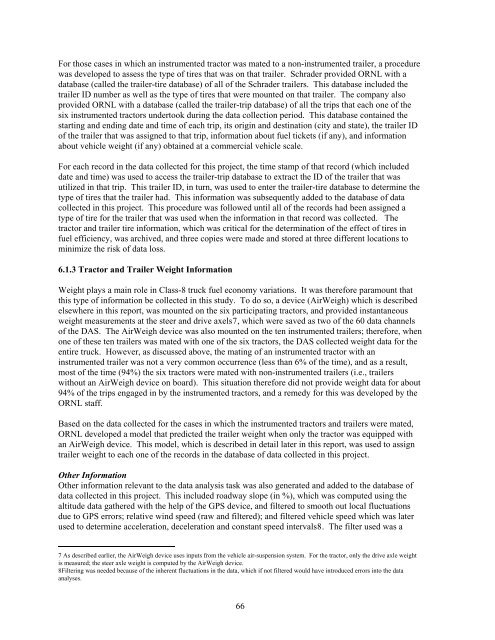Class-8 Heavy Truck Duty Cycle Project Final Report - Center for ...
Class-8 Heavy Truck Duty Cycle Project Final Report - Center for ...
Class-8 Heavy Truck Duty Cycle Project Final Report - Center for ...
Create successful ePaper yourself
Turn your PDF publications into a flip-book with our unique Google optimized e-Paper software.
For those cases in which an instrumented tractor was mated to a non-instrumented trailer, a procedure<br />
was developed to assess the type of tires that was on that trailer. Schrader provided ORNL with a<br />
database (called the trailer-tire database) of all of the Schrader trailers. This database included the<br />
trailer ID number as well as the type of tires that were mounted on that trailer. The company also<br />
provided ORNL with a database (called the trailer-trip database) of all the trips that each one of the<br />
six instrumented tractors undertook during the data collection period. This database contained the<br />
starting and ending date and time of each trip, its origin and destination (city and state), the trailer ID<br />
of the trailer that was assigned to that trip, in<strong>for</strong>mation about fuel tickets (if any), and in<strong>for</strong>mation<br />
about vehicle weight (if any) obtained at a commercial vehicle scale.<br />
For each record in the data collected <strong>for</strong> this project, the time stamp of that record (which included<br />
date and time) was used to access the trailer-trip database to extract the ID of the trailer that was<br />
utilized in that trip. This trailer ID, in turn, was used to enter the trailer-tire database to determine the<br />
type of tires that the trailer had. This in<strong>for</strong>mation was subsequently added to the database of data<br />
collected in this project. This procedure was followed until all of the records had been assigned a<br />
type of tire <strong>for</strong> the trailer that was used when the in<strong>for</strong>mation in that record was collected. The<br />
tractor and trailer tire in<strong>for</strong>mation, which was critical <strong>for</strong> the determination of the effect of tires in<br />
fuel efficiency, was archived, and three copies were made and stored at three different locations to<br />
minimize the risk of data loss.<br />
6.1.3 Tractor and Trailer Weight In<strong>for</strong>mation<br />
Weight plays a main role in <strong>Class</strong>-8 truck fuel economy variations. It was there<strong>for</strong>e paramount that<br />
this type of in<strong>for</strong>mation be collected in this study. To do so, a device (AirWeigh) which is described<br />
elsewhere in this report, was mounted on the six participating tractors, and provided instantaneous<br />
weight measurements at the steer and drive axels7, which were saved as two of the 60 data channels<br />
of the DAS. The AirWeigh device was also mounted on the ten instrumented trailers; there<strong>for</strong>e, when<br />
one of these ten trailers was mated with one of the six tractors, the DAS collected weight data <strong>for</strong> the<br />
entire truck. However, as discussed above, the mating of an instrumented tractor with an<br />
instrumented trailer was not a very common occurrence (less than 6% of the time), and as a result,<br />
most of the time (94%) the six tractors were mated with non-instrumented trailers (i.e., trailers<br />
without an AirWeigh device on board). This situation there<strong>for</strong>e did not provide weight data <strong>for</strong> about<br />
94% of the trips engaged in by the instrumented tractors, and a remedy <strong>for</strong> this was developed by the<br />
ORNL staff.<br />
Based on the data collected <strong>for</strong> the cases in which the instrumented tractors and trailers were mated,<br />
ORNL developed a model that predicted the trailer weight when only the tractor was equipped with<br />
an AirWeigh device. This model, which is described in detail later in this report, was used to assign<br />
trailer weight to each one of the records in the database of data collected in this project.<br />
Other In<strong>for</strong>mation<br />
Other in<strong>for</strong>mation relevant to the data analysis task was also generated and added to the database of<br />
data collected in this project. This included roadway slope (in %), which was computed using the<br />
altitude data gathered with the help of the GPS device, and filtered to smooth out local fluctuations<br />
due to GPS errors; relative wind speed (raw and filtered); and filtered vehicle speed which was later<br />
used to determine acceleration, deceleration and constant speed intervals8. The filter used was a<br />
7 As described earlier, the AirWeigh device uses inputs from the vehicle air-suspension system. For the tractor, only the drive axle weight<br />
is measured; the steer axle weight is computed by the AirWeigh device.<br />
8Filtering was needed because of the inherent fluctuations in the data, which if not filtered would have introduced errors into the data<br />
analyses.<br />
66
















